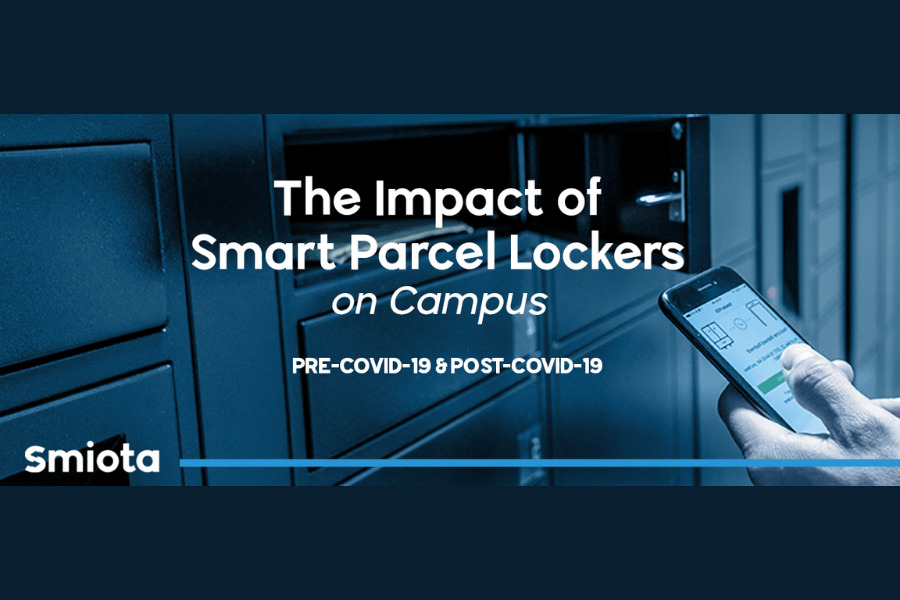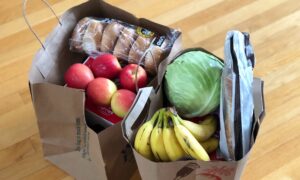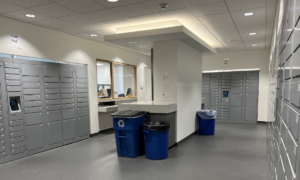College campuses are seeking creative solutions to help keep students and staff safe, which has expedited the adoption of contactless technology like smart lockers. In our recent Q&A-style webinar, higher education consultant Warren Porter discussed his experiences with implementing package lockers on campus and how industry leaders are coping with challenges brought on by COVID-19.
In case you missed it, we put together some of the highlights below. You can also access the full webinar by filling out this quick form.
What did your package management processes look like before smart lockers?
When Porter arrived at the University of Nevada Las Vegas (UNLV) in 2017, leadership agreed that mailroom inefficiencies needed to be addressed.

At UNLV, there were:
- Six buildings and five delivery desks
- 1,800 students living on campus
- 6,500 packages received every month
- ~3.5 packages delivered per student per month
- Over 80,000 packages delivered to the residence halls each year
The old process
Before implementing package lockers, UNLV mailroom staff operated using a manual, paper-based system.
- Parcels arrived at a central location
- Staff manually logged each package
- Package shipped from a central location to individual delivery desks
- At each delivery desk, staff logged the packages again and placed paper notifications in student mailboxes
- If they checked their mailbox, students received a paper notification and picked up their package during operating hours
From initial delivery to pick-up, each package took about 3.2 minutes to handle. With 6,500 packages arriving every month, UNLV staff was spending 240 hours every month on package delivery.
In other words, the university was spending $200,000 per year on package management.
What does the process look like with smart lockers?
With Smiota smart lockers and mailroom software, UNLV was able to streamline its package management system.

- Packages still arrive at a central hub, but now the staff use the Smiota Mailroom software for logging vs. a paper-based system
- Smiota’s simple point-and-scan system automates the chain of custody process and assists with sorting
- Employees deliver the packages to the smart lockers in each residence hall
- When a student has a package waiting for them in the locker, they are automatically alerted via text, email, and/or the Smiota app
- Students can pick up their package at their convenience

We find that 83% of packages are picked up within 12 hours of delivery
With smart lockers, it takes UNLV staff 13 seconds to handle each package, vs. the 3.2 minutes it took using the old paper-based system.
What other benefits did the smart lockers provide?
Besides the time savings, UNLV realized some invaluable financial and organizational benefits after installing smart lockers.
- Students waiting to pick-up packages don’t have to adhere to delivery desk schedules — they can access their packages 24/7
- Desks are no longer double-staffed during peak package delivery and retrieval times
- Staff productivity has doubled
- With increased efficiencies, the university saved over $73,000 each year
- The customer service value of this type of experience for the students is priceless
What happened after you installed the smart lockers?
Installing smart lockers wasn’t the end of the story for UNLV — they wanted to use the new technology to help solve another problem.

UNLV addressed ‘leaf mail’ with smart lockers
At UNLV, about one-third of the 1,800, or roughly 550, students never check their mail. Plus, the old mail lockers took up a ton of wall space and were managed by individual keys.
To help alleviate this problem, the university decided to use the new smart lockers to deliver leaf mail.
New leaf mail process with smart lockers
- All bulk mail (e.g., coupons and flyers) is sorted, approved to put out in the open for student pick-up, and recycled after a certain amount of time
- Mailroom staff puts a barcode on each piece of non-bulk leaf mail
- Mailroom staff scans and deposits mail into lockers
- Students are notified via text, email, and/or Smiota app that they have mail for pick-up.
- Mail that isn’t picked up after a three day expiration is pulled and returned to the mailroom — the locker system automatically notifies the students
How did this change the operation?
- It used to take five students all day to deliver all mail (leaf mail and packages) for 1,800 students
- Now it takes 4 hours max
—
Want to hear more insights about using smart lockers on college campuses and how leadership is navigating COVID-19-related challenges? Stream the full webinar by dropping your email in the form below.




